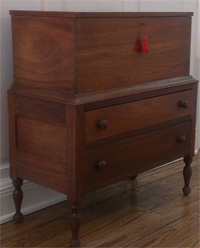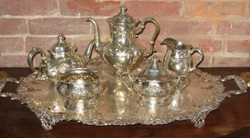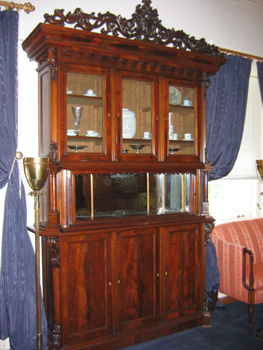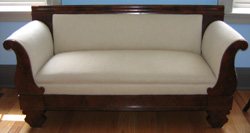Furniture and Decorative Arts in the Old Governor's Mansion
 Walnut and poplar wood Kentucky sugar chest ca.1810-1820, owned by Lazarus Whitehead Powell, 19th Governor of Kentucky (1851-1855) and member of the U.S. Senate (1859-1865). Gift of descendants of Governor Powell for the Kentucky Mansion Celebration. The chest was made in Henderson County, Kentucky.
Walnut and poplar wood Kentucky sugar chest ca.1810-1820, owned by Lazarus Whitehead Powell, 19th Governor of Kentucky (1851-1855) and member of the U.S. Senate (1859-1865). Gift of descendants of Governor Powell for the Kentucky Mansion Celebration. The chest was made in Henderson County, Kentucky.
 Silver engraved tray and tea service. The tray is engraved with pictures of the facades of the Old and New State Capitols. Engraved words on the tray, between the two buildings, reads: "Presented to his Excellency Governor John Crepps Wickliffe Beckham by the citizens of Frankfort, KY December 10th, 1907, on his retirement after a service of nearly eight years as chief Magistrate of Kentucky during which period he was instrumental in the construction of Kentucky's New Capitol building and the preservation of the old one it is requested that this token of gratitude and esteem become the heritage of his son and namesake born during his residence among us E.E. Hume, Mayor of Frankfort and Chairman of committee."
Silver engraved tray and tea service. The tray is engraved with pictures of the facades of the Old and New State Capitols. Engraved words on the tray, between the two buildings, reads: "Presented to his Excellency Governor John Crepps Wickliffe Beckham by the citizens of Frankfort, KY December 10th, 1907, on his retirement after a service of nearly eight years as chief Magistrate of Kentucky during which period he was instrumental in the construction of Kentucky's New Capitol building and the preservation of the old one it is requested that this token of gratitude and esteem become the heritage of his son and namesake born during his residence among us E.E. Hume, Mayor of Frankfort and Chairman of committee."
 An imposing mahogany wood breakfront /display cabinet circa 1870 in a heavy Rococo style. Made for Mr. Philip Swigert of Frankfort Kentucky, pieces like this were often meant to memorialize a milestone in someone's life as seen in the very detailed inlay work depicting Masonic symbols. Many of the inlaid images represent important dates to the Swigert family. Reported to be made in Frankfort Kentucky, but more than likely made in a northern state and imported to a local furniture shop. Consisting of an ornately carved crest above a lighted (glazed) cabinet with three (3) doors over a mirrored central section with tambour doors over three (3) bottom doors. The applied crest features the Masonic symbols of a crown and cross and heavy dentil molding in the cornice. Each door has an ivory escutcheon, with the central doors having one (1) working escutcheon and one (1) false escutcheon on the opposite side to give the appearance of symmetry. Chamfered corners are supported by ornate brackets and turned columns. A lead label on the interior of the right bottom door.
An imposing mahogany wood breakfront /display cabinet circa 1870 in a heavy Rococo style. Made for Mr. Philip Swigert of Frankfort Kentucky, pieces like this were often meant to memorialize a milestone in someone's life as seen in the very detailed inlay work depicting Masonic symbols. Many of the inlaid images represent important dates to the Swigert family. Reported to be made in Frankfort Kentucky, but more than likely made in a northern state and imported to a local furniture shop. Consisting of an ornately carved crest above a lighted (glazed) cabinet with three (3) doors over a mirrored central section with tambour doors over three (3) bottom doors. The applied crest features the Masonic symbols of a crown and cross and heavy dentil molding in the cornice. Each door has an ivory escutcheon, with the central doors having one (1) working escutcheon and one (1) false escutcheon on the opposite side to give the appearance of symmetry. Chamfered corners are supported by ornate brackets and turned columns. A lead label on the interior of the right bottom door.
Philip Swigert was the Grand Secretary for the Grand Lodge of Kentucky as well as a respected citizen of Kentucky. He was most likely a Frankfort man and owned the land that was quarried for stone used to build the Franklin County Courthouse. A lodge was chartered in his honor (for which he signed the actual charter) called Philip Swigert Lodge No. 218 located in Fisherville, KY in 1851. The Philip Swigert Lodge co-owned the title to the land of the Masonic Hall at 15116 Old Taylorsville Road, Fisherville, KY. Philip Swigert was also the 'Grand Recorder' of a short lived council of the Masons called “The Grand Council of Royal and Select Masters of the State of Kentucky” that was formed in 1827. Measures 111" high x 59 1/4" wide x 19 1/2"deep.
 Empire settee with ivory upholstery; mahogany and veneered wood, straight top, curved arms, circa 1860. It is said to have been originally owned by Mayor Thomas Hart Shelby, 3rd son of KY's first Governor, Isaac Shelby. It was in Thomas Shelby's mansion "Grassland" in Fayette Co. and was transferred from Waveland to the Division of Historic Properties in 2004.
Empire settee with ivory upholstery; mahogany and veneered wood, straight top, curved arms, circa 1860. It is said to have been originally owned by Mayor Thomas Hart Shelby, 3rd son of KY's first Governor, Isaac Shelby. It was in Thomas Shelby's mansion "Grassland" in Fayette Co. and was transferred from Waveland to the Division of Historic Properties in 2004.
 Tall case clock, circa 1800, from western Virginia or Kentucky. The lower case rests on French type feet with a 5 part string inlay just above the apron. The center panel of the lower case is attached separately to the case with glue blocks from behind, and is framed with pegged stiles and rails. A large and simple cove waist molding transitions the lower case into the central case which contains champhered corners, stile and rail facing and a central door with surrounding cock-bead type molding. The central case terminates with another large cove molding. Hood consists of a broken arch type pediment with fan rosettes and simple cove molding. Three urn finials are above the pediment. A central molded keystone is applied to the tympanum above the door. Four turned columns decorate each corner and the central door is arched with a glass panel held in place with iron sprigs. Clock face is a painted wood panel.
Tall case clock, circa 1800, from western Virginia or Kentucky. The lower case rests on French type feet with a 5 part string inlay just above the apron. The center panel of the lower case is attached separately to the case with glue blocks from behind, and is framed with pegged stiles and rails. A large and simple cove waist molding transitions the lower case into the central case which contains champhered corners, stile and rail facing and a central door with surrounding cock-bead type molding. The central case terminates with another large cove molding. Hood consists of a broken arch type pediment with fan rosettes and simple cove molding. Three urn finials are above the pediment. A central molded keystone is applied to the tympanum above the door. Four turned columns decorate each corner and the central door is arched with a glass panel held in place with iron sprigs. Clock face is a painted wood panel.